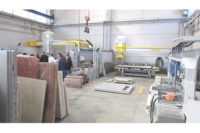

Arte di Granito started in 1995 with only 4 employees. Its business steadily developed over the years, and the increasing demand in the Dutch marketplace for granite countertops led to a further business expansion. One of the first steps taken to improve the overall business was the installation of the BizTops TOPS system, developed in The Netherlands, to process the incoming countertop orders efficiently. In 1999, the company already produced 80 kitchen countertop commissions per week and reached the limits of its capacity in the former production location. Despite the high demand, new customers had to be refused. Therefore, it was decided to build a new factory.

Developing a new plant
In close consultancy with an engineering company and the provider of the automated order processing system, Arte di Granito initiated plans for a new production location. The main goal was to meet the actual market demand but also to provide enough room for further anticipated growth. Other demands for the new factory included reduction of internal transportation time, automatic sawing and automatic CNC routing as well as the general reduction of labor time and the requirement for skilled and trained employees. On the basis of these demands a plan was finalized for a complete new factory by the end of 1999. The plan included the full plant layout, a preferred machine and equipment selection and finally the concept for the IT-structure to run and operate the first industrialized granite production location. The total plant capacity is 400 countertop orders on a weekly basis with only 15 to 20 operators in two shifts. This capacity very strongly depends on the automation level defined. The complete factory concept was designed and implemented as a start-to-finish solution for the manufacturing of granite counter-tops, but can be easily adapted to process engineered stone, solid surfaces or wood. Moreover, the factory design is scalable so smaller-sized plants are feasible.The construction of the building started in 2000 and was carried out under the supervision of Arte di Granito. Further development of the software and the required specialized machinery took place in the same year. The main suppliers were Systraplan GmbH, which established the automated warehouse; L?ffler Maschinenbau GmbH of Germany, which delivered the automatic sawing equipment; and CMS Brembana S.p.A. of Italy, which provided the CNC equipment. The full integration of the production equipment with the order processing software was carried out and supervised by BizTops, bv.
Each component was installed and then integrated to work in concert. By the beginning of 2001, most of the integration had taken place, and in March of 2001, Arte di Granito moved into the new factory. As of that moment, production started in the new environment. After adapting to the newly implemented manufacturing methods, production increased step by step. Now, over one year later, the process runs smoothly, the company reports, although minor adaptations and extensions are to be anticipated.
The production system
Full control of the manufacturing process is governed by the BizTops software system. Incoming orders are entered into the system in a simple program, and they are processed automatically. Documents for on-site templating measurements, order con-firmations--including prices and clear technical drawings--are generated by the system without further manual interference. Once an order has been confirmed, it can be validated
for production. The system then automatically generates all essential production information for every individual part of the countertop, including the routing and processing instructions. Every part of the staged manufacturing process is therefore fully interwoven with the order processing system. The complete production process is monitored and controlled by the BizTops software. This is achieved by the utilization of barcodes in combination with scan stations. The high-tech transportation and warehousing system is fully controlled by automation, and it is designed to safely route slabs and cut-to-size stones to their processing or warehouse storage locations.

Fabrication process
A digitizing step at the beginning of the manufacturing process results in the generation and storage of exact information on the contour and defects of every individual raw slab. The main challenges to implement this contour/defect-detecting step were discovering the optimal lighting conditions and handling the multiple natural occurring color variations of granite.A second step manages the transportation and storage of the raw slabs in the automated warehouse. The raw slabs are identified by their individual barcodes. At this point, two basic data streams can be combined to optimize utilization of raw material. The nesting process considers the need for individual countertop parts - based on orders in the processing system - and the available effective surface of the raw slabs in the warehouse, taking into account the exact geometry and the defects of each slab. The nesting technology also had to consider the additional requirements for waterfall edges on countertops, which is a frequent request by the Dutch market.
The results of this nesting process are stored and form the basis of the specific sawing strategy used for every individual raw slab. This cutting plan is projected on the raw slab so the stone can be exactly positioned on a sawing pallet. Prior to the sawing, the projected cut-to-size stones are marked with barcode stickers. Then, the specially designed L?ffler saw, which features special loading facilities, cuts the raw slab automatically - without operator intervention - to produce the required cut-to-size stones. The guillotine cuts made by the saw require that the resulting stones must be shifted in order to be able to rotate the sawing table and cut in another direction. For this purpose, L?ffler designed and implemented a special "shifting finger" add-on for the machine.
The cut-to-size stones are individually stored into an automated warehouse, which serves as a buffer in the overall process. This warehouse is crucial for efficient production, and the proper utilization of this storage is vital for reaching the specified production capacity. The establishment of a production buffer was a new working method for Arte di Granito, since the former production process was much more oriented towards a day-to-day production schedule.
The buffer warehouse is surrounded by the areas for polishing, CNC stoneworking and laminating. The routing of the workpiece from machine to machine is controlled by the software, and the transport runs automatically. The system for loading the slabs onto the CNC machines again was specially designed and implemented for Arte di Granito. This procedure ensures that the only operator activity consists of the correct positioning of the stone to a predefined reference point, with the rest of the CNC operation running automatically.

Final inspection
For each order, all individual parts that have been fabricated to completion are finally expelled by the buffer warehouse and combined for the last manufacturing steps, which include manual quality control and subsequent transfer to the expedition area where they are made ready for shipping. For all approved orders, the software system automatically generates the required documents such as the bill of lading, freight letter, and other paperwork. Once orders have been shipped to the customer, the software takes care of the last required step: creation of an invoice.Due to the nature of the order processing at Arte di Granito, users can easily gain access to real-time order and production information stored in the system. The total system as implemented allows monitoring of all individual countertop parts running in the production and for every manufacturing step. This not only allows for all parts to be tracked by the system, but also provides a means for transmitting crucial production or last-minute information to plant operators.
Although the implementation and magnitude of the project was extensive, the initial goals were reached. The new factory has a high output, a reduced number of required operators, the most advanced technological approach to automatic granite processing without making a concession towards the quality and complexity of the produced orders, according to the company.




